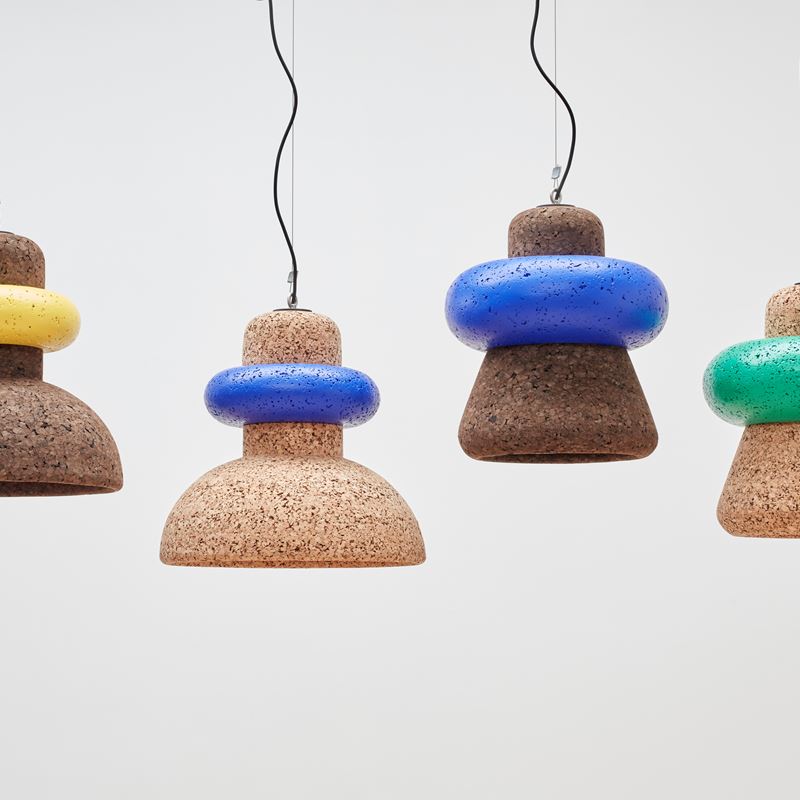When did you decide that cork would be the main “star” of your work?
My studio started experimenting with cork back in 2010, it took a lot of time and experimenting to learn how the material works and to understand the various grades and the properties of the material.
Joaquim Sá, the Managing Director of Amorim Cork, South Africa has always been a wonderful supporter of my work. From the very outset, Joaquim assisted my studio with samples and information including highly informative trips to Amorim headquarters in Portugal where I was privileged to meet the Amorim team and view the factories and also the cork oak forests.
I also had the privilege to host Mr. António Rios de Amorim, who officially opened my new building and studio to the public in September 2015.
When I first started experimenting with cork I realised its wonderful properties and manufacturing capabilities. It soon became evident to me that I wanted to place my focus on cork and make it one of our core materials.
An important motivational factor was to push the limits and add value to this material on an international level. In so doing we had to create awareness and push the boundaries to achieve a number of world “firsts” – including the world’s largest cork pendant light and cork cabinet.
We therefore started placing emphasis on developing special techniques in order to manufacture the products that my studio sells today.
How would you define the role of Amorim in your work?
At this stage, the main role of Amorim within my business is that of a cork supplier. Amorim Cork has however been very supportive over the years and our relationship has evolved into a partnership, this is due to our shared passion for cork.
Amorim South Africa and Wiid Design do however work together on selected projects whereby we collaborate. Until now, however, these projects have been relatively small and in the future I hope to work on larger and more influential projects with Amorim. Especially on an international level, enabling us to design unique pieces with the assistance of Amorim South Africa and Amorim
Through your work over recent years you have become a true ambassador of cork in the world of design and, more specifically, in the world of South African design. Do you think that since 2013 the perception of cork among your peers has changed in any way?
100% Its always been one of my personal goals to educate the local market about cork. It’s been a challenge up until now, because for most clients, when they don’t understand a material they are generally more reluctant to purchase products that are manufactured using it.
Over the past few years I can however confidently stay that the market has accepted the material within product design, specifically within the furniture, lighting and objects categories. It’s important for the industry to support sustainable practices and promote sustainable materials.
Therefore cork found its niche in our local market and I am hoping that the industry will continue to support the material in larger projects in future.
Do you feel there are differences between how cork is perceived by designers and consumers, depending on where you are?
There will always be different perceptions, especially in the countries where one exhibits. Certain design fairs specialise in exhibiting only collectible high-end design, where others focus on commercial products. Most European exhibitors or retailers will have a better understanding of the products presented due to their general knowledge of materials and design.
I have therefore found that our products are better suited for the USA, Europe, UAE and Australian markets as opposed to the South African market. There are many reasons for this, but one reason might be due to the style of our collection. Our work has a very unique contemporary look and feel that relates to consumers that have a dedicated interest in design.
Designers and consumers from certain countries are also more aware of the various materials available and the possibilities that these materials can create within design. It’s almost an educated open mindedness that creates these different perceptions.
What about South African consumers? What is their perception and knowledge about the material?
The understanding of cork as a multiuse material in South Africa is certainly increasing, but it is still relatively limited to the wine industry and very rare in the product design industry. The experience I have gained by working with Architects, Interior Designers and some of our private clients shows that there is a indeed a need for cork within projects.
It is important to note that South Africa does not have a large high-end consumer market and the products we manufacture are of the best quality and therefore focus on a fairly niche market.
Is there anything you can reveal us about future projects? More cork applications in the making?
We are constantly working on projects where we develop and design custom products for clients. Currently we are focusing on incorporating cork within smaller products that are more suitable for the general consumer market. These products will include desk lights, new planters, kitchenware and smaller furniture items.
We are also busy developing new products for international Nando’s stores including more high-end product collections that can be exhibited at international design fairs.
